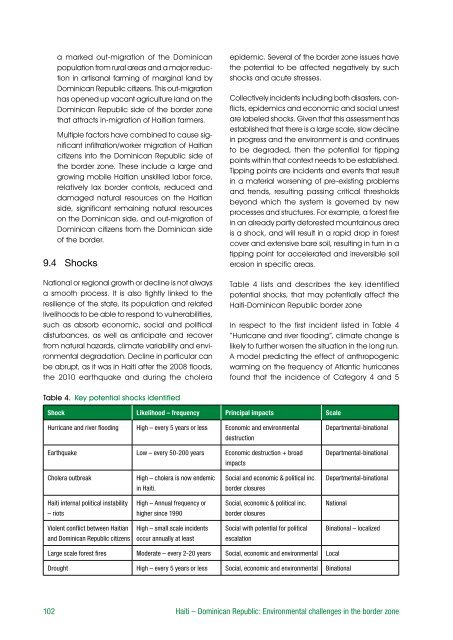Haiti – Dominican Republic - Disasters and Conflicts - UNEP
Haiti – Dominican Republic - Disasters and Conflicts - UNEP
Haiti – Dominican Republic - Disasters and Conflicts - UNEP
- No tags were found...
You also want an ePaper? Increase the reach of your titles
YUMPU automatically turns print PDFs into web optimized ePapers that Google loves.
a marked out-migration of the <strong>Dominican</strong>population from rural areas <strong>and</strong> a major reductionin artisanal farming of marginal l<strong>and</strong> by<strong>Dominican</strong> <strong>Republic</strong> citizens. This out-migrationhas opened up vacant agriculture l<strong>and</strong> on the<strong>Dominican</strong> <strong>Republic</strong> side of the border zonethat attracts in-migration of <strong>Haiti</strong>an farmers.Multiple factors have combined to cause significantinfiltration/worker migration of <strong>Haiti</strong>ancitizens into the <strong>Dominican</strong> <strong>Republic</strong> side ofthe border zone. These include a large <strong>and</strong>growing mobile <strong>Haiti</strong>an unskilled labor force,relatively lax border controls, reduced <strong>and</strong>damaged natural resources on the <strong>Haiti</strong>anside, significant remaining natural resourceson the <strong>Dominican</strong> side, <strong>and</strong> out-migration of<strong>Dominican</strong> citizens from the <strong>Dominican</strong> sideof the border.9.4 ShocksNational or regional growth or decline is not alwaysa smooth process. It is also tightly linked to theresilience of the state, its population <strong>and</strong> relatedlivelihoods to be able to respond to vulnerabilities,such as absorb economic, social <strong>and</strong> politicaldisturbances, as well as anticipate <strong>and</strong> recoverfrom natural hazards, climate variability <strong>and</strong> environmentaldegradation. Decline in particular canbe abrupt, as it was in <strong>Haiti</strong> after the 2008 floods,the 2010 earthquake <strong>and</strong> during the choleraepidemic. Several of the border zone issues havethe potential to be affected negatively by suchshocks <strong>and</strong> acute stresses.Collectively incidents including both disasters, conflicts,epidemics <strong>and</strong> economic <strong>and</strong> social unrestare labeled shocks. Given that this assessment hasestablished that there is a large scale, slow declinein progress <strong>and</strong> the environment is <strong>and</strong> continuesto be degraded, then the potential for tippingpoints within that context needs to be established.Tipping points are incidents <strong>and</strong> events that resultin a material worsening of pre-existing problems<strong>and</strong> trends, resulting passing critical thresholdsbeyond which the system is governed by newprocesses <strong>and</strong> structures. For example, a forest firein an already partly deforested mountainous areais a shock, <strong>and</strong> will result in a rapid drop in forestcover <strong>and</strong> extensive bare soil, resulting in turn in atipping point for accelerated <strong>and</strong> irreversible soilerosion in specific areas.Table 4 lists <strong>and</strong> describes the key identifiedpotential shocks, that may potentially affect the<strong>Haiti</strong>-<strong>Dominican</strong> <strong>Republic</strong> border zoneIn respect to the first incident listed in Table 4“Hurricane <strong>and</strong> river flooding”, climate change islikely to further worsen the situation in the long run.A model predicting the effect of anthropogenicwarming on the frequency of Atlantic hurricanesfound that the incidence of Category 4 <strong>and</strong> 5Table 4. Key potential shocks identifiedShock Likelihood <strong>–</strong> frequency Principal impacts ScaleHurricane <strong>and</strong> river flooding High <strong>–</strong> every 5 years or less Economic <strong>and</strong> environmentaldestructionEarthquake Low <strong>–</strong> every 50-200 years Economic destruction + broadimpactsDepartmental-binationalDepartmental-binationalCholera outbreakHigh <strong>–</strong> cholera is now endemicin <strong>Haiti</strong>.Social <strong>and</strong> economic & political inc.border closuresDepartmental-binational<strong>Haiti</strong> internal political instability<strong>–</strong> riotsHigh <strong>–</strong> Annual frequency orhigher since 1990Social, economic & political inc.border closuresNationalViolent conflict between <strong>Haiti</strong>an<strong>and</strong> <strong>Dominican</strong> <strong>Republic</strong> citizensHigh <strong>–</strong> small scale incidentsoccur annually at leastSocial with potential for politicalescalationBinational <strong>–</strong> localizedLarge scale forest fires Moderate <strong>–</strong> every 2-20 years Social, economic <strong>and</strong> environmental LocalDrought High <strong>–</strong> every 5 years or less Social, economic <strong>and</strong> environmental Binational102 <strong>Haiti</strong> <strong>–</strong> <strong>Dominican</strong> <strong>Republic</strong>: Environmental challenges in the border zone
















